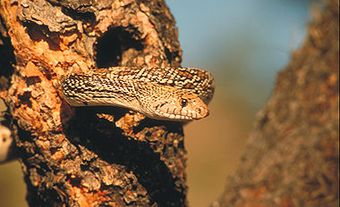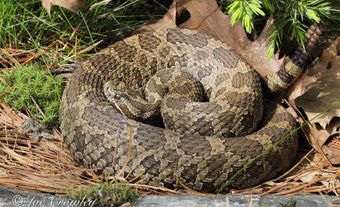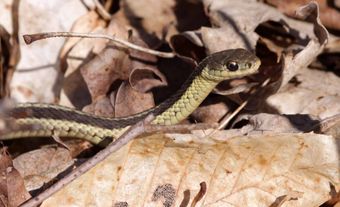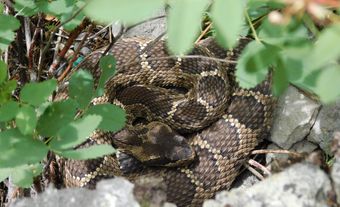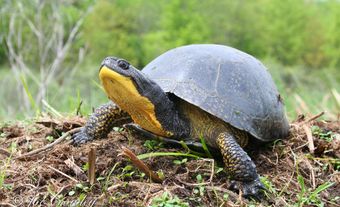The common watersnake (Nerodia sipedon) is a medium-sized, non-venomous snake native to North America. Within Canada, it is found in the southern portions of Ontario and Quebec. In the US, its range extends south to Florida and west to Colorado. Of the four officially recognized subspecies, two are found in Canada: the Northern watersnake (Nerodia sipedon sipedon) and the Lake Erie watersnake (Nerodia sipedon insularum). (See also Snake Species in Canada.)

Description
The common watersnake is a medium-sized snake. Although females have the potential to grow to nearly 1.5 m long, individuals rarely come close to that size and are more commonly around 70 cm in length. The much smaller males, meanwhile, are between 45 and 55 cm long on average.
The scales of the watersnake are keeled, meaning each scale has a small ridge down the middle. These ridges give the snake an overall appearance of roughness, rather than smooth shininess.
Common watersnakes can be greyish, greenish, or drab brown. Some have distinct banding and blotching patterns, while others have no patterns at all. Northern watersnakes generally have more regular patterning and blotches, although these shapes can sometimes be difficult to see. In contrast, Lake Erie watersnakes tend to lack a distinct pattern and are generally more greyish in colouration.

Distribution and Habitat
Within Canada, the common watersnake can be found in the southern portions of Ontario and Quebec. They can also be found in the Eastern United States, where various subspecies of the common watersnake live in habitats as far south as Florida and as far west as Colorado.
The preferred habitat of watersnakes is in and around permanent bodies of water, including lakes, rivers and wetlands. Common watersnakes are excellent swimmers, able to swim up to 3 m under the water’s surface and many kilometres from shore.
Did you know?
All snakes can swim. However, some species spend more time in the water than others. Semi-aquatic snakes, like the common watersnake, are skilled swimmers and spend a significant amount of time in water, whereas truly aquatic snakes, typically found in tropical seas, spend all (or almost all) of their time in water.
It is important for watersnakes’ habitat to have ample basking spots, including rocks, logs and even certain manmade structures, where the snakes can warm themselves in the sun while remaining close to the water. This allows these cold-blooded animals to regulate their body temperature while also being able to quickly flee into the water if disturbed.
The subspecies Lake Erie watersnake is exclusively found on the islands of the Lake Erie archipelago, as well as small parts of the Ohio shoreline. They are one of the most geographically limited snakes in North America, with a global range of less than 40 km in diameter.
Reproduction and Development
Watersnakes mate in May and June, with multiple male snakes courting a single female simultaneously. Female watersnakes give birth to live young in late summer and early fall. One female can give birth to anywhere from about 12–46 offspring in a single breeding season and will commonly breed annually. Watersnakes do not provide parental care to their offspring, and newborns are able to move and swim very soon after they are born. Young snakes spend most of their time hiding in dense cover and hunting for prey when needed. It takes 3–4 years for juvenile watersnakes to reach sexual maturity in Canada, and they can live for 12 years or more in the wild.
Diet and Predation
Common watersnakes hunt for prey along the water’s edge and underwater, feeding on fish, amphibians, crayfish and occasionally rodents (CHS, Cecala et al 2010). In certain parts of the watersnake’s range up to 90 per cent of its diet consists of the round goby (Apollonia melanostomus). The round goby is a species of invasive fish that arrived in the Canadian Great Lakes in the 1990s. (See also Invasive Species in Canada: Animals.)
Known predators of watersnakes include the great blue heron (Ardea Herodias), various bird species, predatory fish, raccoons, red foxes, other snakes and domesticated animals such as cats and dogs.

Status and Threats
The common watersnake is considered “least concern” by the International Union for Conservation of Nature. However, the Committee on the Status of Endangered Wildlife in Canada (COSEWIC) has categorized the Lake Erie subspecies (Nerodia sipedon insularum) as “special concern.”.
The greatest threat to common watersnakes may be human persecution. Despite protective legislation, humans are known to seek out and kill watersnakes, sometimes in large numbers, due to the mistaken belief that they are dangerous, or else because they are simply disliked. Watersnakes are non-venomous and not aggressive, preferring to escape into the water when disturbed, but they may bite defensively if cornered or harassed.
These snakes are additionally threatened by habitat loss and road mortality. The shores of the lakes and rivers where they live are popular locations for tourists and cottages. In addition, the development of key areas such as Georgian Bay and Pelee Island in Canada have caused the snake’s preferred habitat to be destroyed and fragmented in many places. Watersnakes must travel inland in order to find a place to hibernate for the winter. Increasingly, they must travel across roads to reach such locations, which results in numerous road mortalities each year.

 Share on Facebook
Share on Facebook Share on X
Share on X Share by Email
Share by Email Share on Google Classroom
Share on Google Classroom
